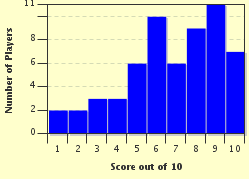Quiz Answer Key and Fun Facts
1. The Thirty Years' War is commonly said to have begun with the (Second) Defenestration of Prague when two officials and their secretary were punished by religious rivals. What is defenestration?
2. An important figure in the early days of the Thirty Years' War was Frederick V, Elector of the Palatinate and briefly King of Bohemia. By which rather insulting--if seasonal--title was he known?
3. The period before the Thirty Years' War had seen the Peace of Augsburg determine religious affiliation in local areas of the Holy Roman Empire. Under this agreement, which two religions could a local leader choose from for his/her territory?
4. While the Thirty Years' War is sometimes seen as a religious war, the sides did not always neatly divide on religious lines. Which majority Catholic nation fought against the Catholic Hapsburg dynasty from 1635 to the end of the war?
5. An important ruler and military commander in the first half of the Thirty Years' War was Gustavus Adolphus or Gustav II Adolf. Of which country was Gustavus the ruler?
6. Which modern nation regained its independence during the Thirty Years' War, several decades after being involuntarily being placed under the control of the monarch of another nation?
7. Which military leader was NOT active during the Thirty Years' War?
8. Which nation was most harmed by the Thirty Years War--perhaps because many of the battles were fought within its territory?
9. The Thirty Years' War was brought to an end in 1648 with a series of Treaties. What is the collective name given to these treaties?
10. Which of the following was NOT an outcome of the Peace of Westphalia?
Source: Author
bernie73
This quiz was reviewed by FunTrivia editor
bloomsby before going online.
Any errors found in FunTrivia content are routinely corrected through our feedback system.


